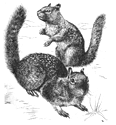Vertebrate Pest Conference Proceedings collection
Date of this Version
March 1976
Abstract
Under an Environmental Protection Agency (EPA) contract, we evaluated the hazards associated with strychnine baiting for pocket gophers (Geomys bursarius) with the burrow-builder. On the Sherburne National Wildlife Refuge, Minnesota, we treated 662 ha (1638 acres) with 0.5 percent strychnine-treated bait. Treated fields were scattered throughout 10 sections. Control was effective--data from pocket gopher activity plots showed 87.5 ± 5.9 percent reductions in activity. Populations of other small rodents (while quite low) significantly declined on the treated area, but significantly increased on the control area. To measure secondary effects we equipped 36 raptors and 36 mammalian predators with radio transmitters. We detected little, if any, effect on radio-equipped raptors and mammalian predators. Red-tailed hawks (Buteo jamaicensis), American kestrels (Falco sparverius), great horned owls (Bubo virginianus), badgers (Taxidea taxus), striped skunks (Mephitis mephitis), red fox (Vulpes fulva) and a coyote (Canis latrans) were intensively radio-tracked during treatment; those that utilized treated fields all survived. Mammalian predator tracks and diggings were frequently observed on the burrow-builder tracks after treatment. Red-winged blackbirds (Agelaius phoeniceus) were selected as a representative of seed-eating birds. We marked 100 territorial males on both the treated and control area and monitored them during the treatment. Even though some treated grain was available on the surface and marked birds were observed feeding in treated fields, we did not detect any detrimental effects. Nevertheless, we found one treatment-killed mourning dove (Zenaida macroura).

